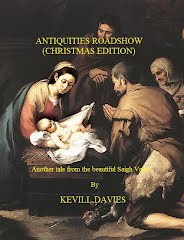
CARAVACA de la CRUZ

MY WIFE and I attended the
dinner, recently held at the
hotel Puntazo to raise funds
for ACEM, the new group set
up to promote Mojácar. (Let
me say straight away that
the food was excellent. Well
done the Puntazo).
ACEM's aims are to bring
more visitors to Mojacar
throughout the year in a
move calculated to help sustain the bars, restaurants and other businesses that
depend on a fresh infusion of customers. The task is not easy, when they have so few out of season attractions to promote, other than to look at the Mediterranean and the beaches. Even the label of being a town with history, a lure for elderly Spaniards, perhaps, is not sufficient to divert an ever more discerning group of North Europeans from the historical sites of say, Cyprus, Crete and Turkey.
This week, we visited the town of Caravaca de la Cruz, about 70kms west of Murcia on the C-415, and in particular, the sanctuary that sits atop a hill in the old quarter. We were able to
tour the church and view the relic that gives the town it's name. Now, until this week, I
had never heard of the place but undoubtedly others have because, even in February, there was a constant stream of visitors, either individually or in groups. The relic, a small double armed cross, like the Cross of Lorraine, was reputedly fashioned from the wood of Christ's cross at Calvary, this particular cross being a symbol associated with the first Bishop or Patriarch of
Jerusalem. It resides in a little, dimly lit side chapel and is simply stunning; well worth the journey. Now, I cannot prove or disprove the provenance of this piece and ignoring the undoubted truth that if all the pieces that allegedly came from the cross were authentic, it
would need to have been a hundred times larger than it actually was, the story of
 Caravaca is appealing, the setting atmospheric and the
Caravaca is appealing, the setting atmospheric and theeffect satisfying. What a shame, I thought, that the
church in Mojácar doesn't have say, an image of the
Virgin that cries tears of blood or that the fuente
doesn't make good, leprous limbs. If you've ever been to Lourdes you would know what I mean.
I remember, some years ago, going to Cadiz on a
three day trip. One of the reasons for going was to
visit the Cathedral and its 'million' monstrance, a reliquary that was said to be bejewelled with a 'million' gems. Sadly for each of the three days the cathedral was closed for repairs, meaning that I'll have to return one day to see the piece. I mention
this because I think it's important for the organisers
of ACEM to find and highlight some degree of uniqueness; something that sets Mojácar apart and gives motive for visitors to come to our beautiful town out of season. If you, the readers have any suggestions, please contact the Reader.es and let us know your ideas.
I have developed a website with my
Titan ideas for promoting Mojacar, online. Please visit and leave your comments.
http://sites.google.com/site/marblegolf/
Kevill Davies is author of
'Apsaras'. Available at most on
line book shops.
THE STORY OF THE CROSS
THE CARAVACA CROSS shows a Corus on a Patriarchal Cross, often flanked by two Angels. The upper of the two bars on the Patriarchal Cross is normally a titulus, bearing an inscription; the Caravaca Cross is unusual in that Christ's arms are nailed to the upper bar. In the early eighth century, Arabs and Berbers invaded the Iberian Peninsula and occupied the territory.
It took almost 800 years for Christians to reconquer the land. In about the middle of that period, in the year 1231 (or 1232 by some accounts), a miracle occurred in the south-eastern
Spanish town of Caravaca de la Cruz. The town is set among the rugged sierras of Murcia, which at that time was still a Moorish kingdom under Zeyt-Abuzeyt. Being several generations
away from the initial invaders, he was from a line of well-established monarchs and one of his duties was to protect the region from invasion by the Christians. The Christian reconquest
took various forms; from fighting to gradual infiltration through missionaries. One such Christian
missionary was Don Gínes Pérez Chirinos de Cuenca. He was captured and taken before the Muslim king who was curious about certain aspects of the Christian faith. In particular, he was
interested in the Christian celebration of the Last Supper and asked the missionary to demonstrate the procedure. One can imagine the priest would be reluctant to do this - in those days only believers were present during the sacrament. Nevertheless, he agreed and the king
arranged for the necessary apparatus: an altar draped with a pall cloth, bread and wine, and some candles. One important element, however, was missing: the cross. The missionary explained that the presence of a cross was critical to the Eucharist and he could not continue
without one. "So what is that?" protested the king, pointing to something at the window. From the heavens, two angels appeared carrying a cross, which they placed on the altar and then disappeared. The priest continued with the Mass. In the Roman Catholic church, when the bread and wine are consecrated during Mass, they cease to be bread and wine, and become instead
the body and blood of Christ. The empirical appearances are not changed, but the reality is. When the missionary reached the consecration stage, the king saw a beautiful baby instead of the bread. The king was so taken aback by this miraculous image that he, and his family, converted to Christianity and asked to be baptized into the Christian faith. Many believe
that the cross delivered by the angels included a piece of the True Cross (Lignum Crucis).

The miracles didn't stop there.
Eventually, the town passed to the
Knights Templar who, in the 15th century,
built the castle that still dominates
the town today. At one time, the
Knights Templar and townsfolk were
under siege by the Muslim army and
tool refuge in the castle. It wasn't long
before the water stored in the castle
became undrinkable and several of
the refugees became ill. Scouts crept
out of the castle at night to look for
water but found the neighbouring
wells had been poisoned. In desperation,
the scouts raced out of the castle
on horses to find a safe source of
water. They found some wine, loaded
the wineskins on their horses and
raced back to the castle.
The wine was blessed in the presence
the Caravaca Cross and served
to those who had been
debilitated by the bad water. They recovered immediately and the blessed wine was mixed
with the toxic water in the storage tanks. The water became fresh and as a result, the Christians
were able to resist the enemy. Today, an annual fiesta is held in the town to remember those events, which includes a ceremony to bless the irrigation water used by Caravaca farmers.
Because of these miracles and the relic of the True Cross, kept in the Sanctuario de la Santa Cruz, Caravaca de la Cruz became only the fifth holy town, granted by the Vatican in 1998, to celebrate the Perpetual Jubilee. The others are Rome, Jerusalem, Santiago de Compostela, and Santo Toribio de Liébana (Cantabria). The first celebration was in 2003 and was attended by the then Cardinal Ratzinger; now Pope Benedict XVI. This year (2010), in May (1st-5th), the
celebration will again be held. Centuries later, after Christopher Columbus set sail on his voyage of discovery (1492) Franciscan monks travelled to the Americas, taking copies of the Caravaca cross with them. The design is still commonly seen in Central and South American churches and monasteries. Houses and business premises also have copies pinned to the wall, like lucky
charms, and may be surrounded by a lucky horseshoe.






No comments:
Post a Comment